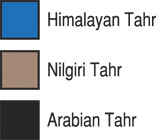 |
 |
Hemitragus jemlahicus
Tar del Himalaya (Sp), Himalaya Tahr (G), Tahr de Himalaya (F). The English derivation of the Nepali name for this animal may be spelled "tahr" or "thar." Neither is "correct," but "tahr" is preferred by most English publications. The generic name is from the Greek hemi (half) and tragos (a goat), or "half-goat." The specific name jemlahicus may be from "Himalaya," which is derived from the Sanskrit hima (snow) and alaya (abode).
DESCRIPTION Shoulder height 36-40 inches (140-155 cm). Weight 180-200 pounds (82-91 kg), sometimes more. The female is a good deal smaller. Chromosome number is 48.
A medium-sized, powerfully built animal with a full coat of hair and a shaggy mane around the neck and shoulders and extending to the knees. The overall color varies, but in most cases is dark reddish-brown with a yellowish mane and a dark, sometimes indistinct, dorsal stripe. The face is always dark brown. The horns (both sexes) are short and stout, laterally compressed, keeled in front and curved backward to a tapered point. According to Stockley (1928), horns of 14 inches (35.6 cm) were exceptional and 11-1/2 inches (29.2 cm) shootable. The longest of record measured 16-3/4 inches (42.5 cm) (Rowland Ward, 1927). The female has smaller horns, lacks a mane, and has two pairs of teats (like the Arabian tahr, but unlike the Nilgiri tahr, which has one pair).
BEHAVIOR Gregarious, in large herds, with adult males forming separate herds during the summer. Prefers to live on steep slopes that are more or less timbered. Females prefer open summit areas, males the wooded cliffs below. The tahr has remarkable climbing ability on the steepest cliffs. Does not like snow, keeping below it to as low as 5,000 feet (2,200 m), then following it up as it melts. Active morning and evening, resting midday. Feeds on grasses and foliage. Wary and difficult to approach. Eyesight very good, hearing and sense of smell not known.
HABITAT A combination of big cliffs, rocks and forest.
DISTRIBUTION A narrow strip along the southern flanks of the Himalayas from about Banihal Pass in the Pir Panjal Range of northern India eastward to Bhutan. Penetrates the main Himalayan Range only in some of the large gorges.
Outside Asia, has been introduced in the wild on the South Island of New Zealand and in parts of South Africa, and on private properties in the United States, Argentina and Austria. Other introductions in Scotland and Canada have failed.
REMARKS An excellent game animal that provides sport as fine as any in the world. "Tahr inhabit, perhaps, the worst ground on which it is possible for a large mammal to exist, and it is to this that many sportsmen owe the loss of some of their finest trophies." (Richard Lydekker)
|





